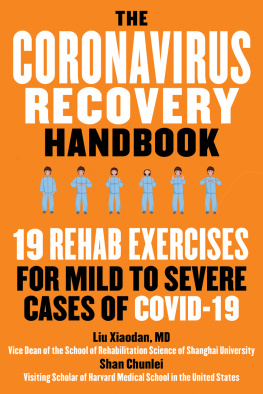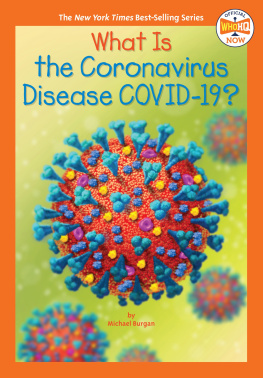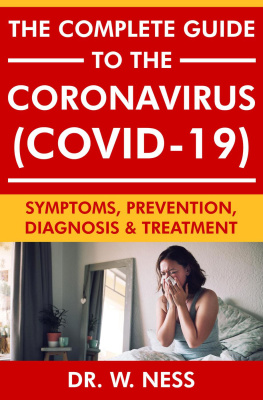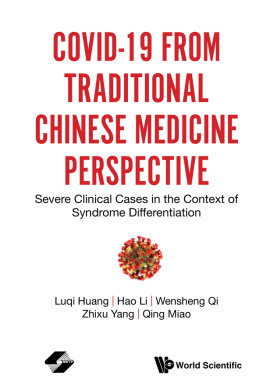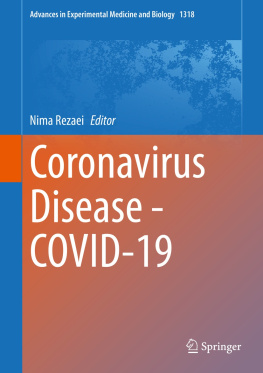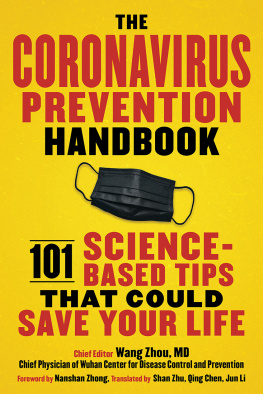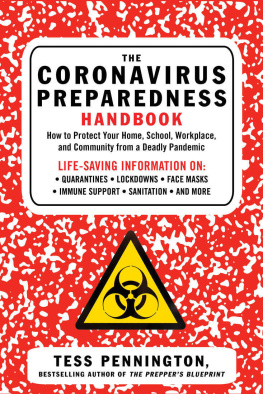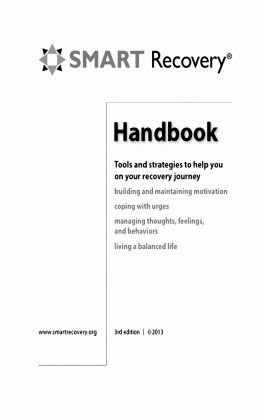Liu Xiaodan - The Coronavirus Recovery Handbook: 19 Rehab Exercises for Mild to Severe Cases of COVID-19
Here you can read online Liu Xiaodan - The Coronavirus Recovery Handbook: 19 Rehab Exercises for Mild to Severe Cases of COVID-19 full text of the book (entire story) in english for free. Download pdf and epub, get meaning, cover and reviews about this ebook. year: 2020, publisher: Skyhorse, genre: Home and family. Description of the work, (preface) as well as reviews are available. Best literature library LitArk.com created for fans of good reading and offers a wide selection of genres:
Romance novel
Science fiction
Adventure
Detective
Science
History
Home and family
Prose
Art
Politics
Computer
Non-fiction
Religion
Business
Children
Humor
Choose a favorite category and find really read worthwhile books. Enjoy immersion in the world of imagination, feel the emotions of the characters or learn something new for yourself, make an fascinating discovery.
- Book:The Coronavirus Recovery Handbook: 19 Rehab Exercises for Mild to Severe Cases of COVID-19
- Author:
- Publisher:Skyhorse
- Genre:
- Year:2020
- Rating:5 / 5
- Favourites:Add to favourites
- Your mark:
- 100
- 1
- 2
- 3
- 4
- 5
The Coronavirus Recovery Handbook: 19 Rehab Exercises for Mild to Severe Cases of COVID-19: summary, description and annotation
We offer to read an annotation, description, summary or preface (depends on what the author of the book "The Coronavirus Recovery Handbook: 19 Rehab Exercises for Mild to Severe Cases of COVID-19" wrote himself). If you haven't found the necessary information about the book — write in the comments, we will try to find it.
Liu Xiaodan: author's other books
Who wrote The Coronavirus Recovery Handbook: 19 Rehab Exercises for Mild to Severe Cases of COVID-19? Find out the surname, the name of the author of the book and a list of all author's works by series.
The Coronavirus Recovery Handbook: 19 Rehab Exercises for Mild to Severe Cases of COVID-19 — read online for free the complete book (whole text) full work
Below is the text of the book, divided by pages. System saving the place of the last page read, allows you to conveniently read the book "The Coronavirus Recovery Handbook: 19 Rehab Exercises for Mild to Severe Cases of COVID-19" online for free, without having to search again every time where you left off. Put a bookmark, and you can go to the page where you finished reading at any time.
Font size:
Interval:
Bookmark:


Copyright 2020 by Central South University Press
Originally published by Central South University Press, Hunan, China.
The world translation rights are exclusively represented by Rightol Media.
()
All rights reserved. No part of this book may be reproduced in any manner without the express written consent of the publisher, except in the case of brief excerpts in critical reviews or articles. All inquiries should be addressed to Skyhorse Publishing, 307 West 36th Street, 11th Floor, New York, NY 10018.
Skyhorse Publishing books may be purchased in bulk at special discounts for sales promotion, corporate gifts, fund-raising, or educational purposes. Special editions can also be created to specifications. For details, contact the Special Sales Department, Skyhorse Publishing, 307 West 36th Street, 11th Floor, New York, NY 10018 or .
Skyhorse and Skyhorse Publishing are registered trademarks of Skyhorse Publishing, Inc., a Delaware corporation.
Visit our website at www.skyhorsepublishing.com.
10 9 8 7 6 5 4 3 2 1
Library of Congress Cataloging-in-Publication Data is available on file.
Cover design by Brian Peterson
Cover images courtesy of Central South University Press
Print ISBN: 978-1-5107-6307-4
Ebook ISBN: 978-1-5107-6310-4
Printed in the United States of America
Table of Contents
About the Authors
Liu Xiaodan, MD, is associate professor, master supervisor, rehabilitation therapist, and vice dean of the School of Rehabilitation Science of Shanghai University of Traditional Chinese Medicine; the chairman of the Occupational Therapy Youth Committee of the Chinese Rehabilitation Medical Association; and vice chairman of the External Treatment Committee of the Shanghai Society of Traditional Chinese Medicine.
In recent years, Liu Xiaodan has been engaged in clinical research on lung rehabilitation for chronic respiratory diseases. During the past five years, she has been mainly responsible for more than ten projects at all levels, including for the National Nature Foundation, and has published more than thirty papers, including ten Science Citation Index (SCI) papers.
The pulmonary-based Qigong rehabilitation protocol (PQRP), which was created by Liu Xiaodan, has recently been featured widely on People.cn, Xinhuanet, the China Health Qigong Association Network, Xuexi.cn, the official website of the General Administration of Sport of China, Tencent, NetEase, and other platforms and media and has obtained much public recognition.
Shan Chunlei is a professor, chief physician, doctoral/postdoctoral supervisor, doctor of the Chinese Academy of Sciences, and a visiting scholar of Harvard Medical School in the United States.
He is dean of Rehabilitation Science, School of Shanghai University of Traditional Chinese Medicine; director of the Rehabilitation Medicine Institute of Shanghai University of Traditional Chinese Medicine; and director of the Rehabilitation Medicine Center of Yueyang Hospital of Integrated Traditional Chinese and Western Medicine, Shanghai University of Traditional Chinese Medicine.
In Shanghai, Shan Chunlei has been recognized as an outstanding academic leader and a leading talent in clinical rehabilitation.
He served as chairman of the traditional Supplementary Integrated Rehabilitation Committee of the Asia-Oceanian Society for NeuroRehabilitation and chairman of the Brain Function Testing and Regulation Rehabilitation Committee of the Chinese Association of Rehabilitation Medicine.
He is a peer reviewer for the second review of the National Natural Science Foundation of China project. He is mainly engaged in clinical and scientific research in rehabilitation medicine using integrated traditional Chinese and Western medicine. He has won the excellent Young and Middle-aged Expert Award for Stroke Prevention and Treatment from the National Health Commission of the Peoples Republic of China, the Outstanding Rehabilitation Physicians Award, and first prize in the Science and Technology Award from the Chinese Association of Rehabilitation Medicine.
He is in charge of one national key research and development program project and three National Natural Science Foundation projects. He has published more than 120 academic papers, including fifty SCI papers. He has edited and participated in the compilation of thirty monographs and textbooks.
About the Book
Recently, coronavirus (COVID-19) has become widespread, and many countries worldwide are experiencing the pandemic.
In response to the call for international and regional cooperation in the fight against the pandemic, for sharing our experience of epidemic prevention and control with relevant countries, and for joint management of the pandemic, which was proposed by the Central Committee of the Communist Party of China, we wanted to publish an English version of the book The Coronavirus Recovery Handbook, to reflect Chinas determination and commitment to building a community with a shared future for humankind.
This book was compiled by the rehabilitation medicine team of Shanghai University of Traditional Chinese Medicine. It was based on the teams previous clinical and scientific research work, combined with relevant national diagnosis and treatment guidance and the clinical experience of many experts involved in the fight against this pandemic. To address the clinical needs of patients with mild and severe COVID-19, this book presents a series of integrated traditional Chinese and Western medicine lung rehabilitation training methods, which have been used in the Shanghai Public Health Clinical Center (affiliated to Fudan University) and Lei Shenshan Hospital in Wuhan.
In particular, it is worth mentioning that the pulmonary-based Qigong rehabilitation protocol (PQRP) introduced in the book has a good rehabilitative effect on patients with mild COVID-19 symptoms or with chronic respiratory diseases. After practice, some patients reported that they experienced smooth breathing, comfortable muscles and that they felt refreshed and relaxed. This set of exercises scientifically integrates the action of regulating lung and breathing functions in the traditional Chinese exercises of Liuzijue, Wuqinxi, Baduanjin, and Yijinjing Qigong. Therefore, these exercises are both scientific and comprehensive. They are also simple and easy to implement. This exercise system is not only based on the ancient theory of traditional Chinese medicine, but also has been tested in modern clinical medicine.
To make it easier for readers to practice by themselves, the book is accompanied by an excellent teaching demonstration video, which is linked to the book with a QR code.
Preface One
In 2020, a novel coronavirus pneumonia (named coronavirus disease 2019, or COVID-19) spread around the world, resulting in serious harm to human lives. Under the strong leadership of President Xi Jinping, the Chinese government is engaged in a vigorous effort to combat the sudden outbreak of this novel virus. A nationwide battle against what is now a pandemic has been initiated, and 1.4 billion Chinese people are united in fighting this war without smoke. At present, the prevention and control of the pandemic is in a critical period; the situation remains severe but is stable and improving.
Patients with COVID-19 often first show respiratory symptoms and have varying degrees of impaired respiratory function. Patients with severe COVID-19 symptoms show dyspnea and hypoxemia, which can develop into acute respiratory distress syndrome with multiple organ failures and dysfunction. For patients with mild or severe COVID-19 symptoms, if treatment is prolonged and the period of physical inactivity is lengthy, complications tend to occur (including pressure ulcers, venous thrombosis, orthostatic hypotension, muscle atrophy, and osteoporosis), and recovery of respiration, circulation, and systemic functions is difficult. Therefore, appropriate and moderate rehabilitation interventions for patients with mild and stable COVID-19 symptoms in the recovery stage will help to prevent complications, promote recovery of cardiopulmonary function and physical fitness, and relieve anxiety and panic. In the current situation, saving lives and preventing the resurgence of the disease remain the top priorities, but rehabilitation can still make a difference and can be initiated before the recovery period. Rehabilitation can be initiated early without affecting the treatment for patients. For example, in the early stage, patients can move their limbs to prevent damage to joint functions, perform sputum-discharging exercises in a variety of positions (including prone position, healthy lateral position, and tapping and rubbing the back), and perform breath training exercises. In the recovery period, patients could practice the PQRP introduced in this book, which helps to improve respiratory function.
Next pageFont size:
Interval:
Bookmark:
Similar books «The Coronavirus Recovery Handbook: 19 Rehab Exercises for Mild to Severe Cases of COVID-19»
Look at similar books to The Coronavirus Recovery Handbook: 19 Rehab Exercises for Mild to Severe Cases of COVID-19. We have selected literature similar in name and meaning in the hope of providing readers with more options to find new, interesting, not yet read works.
Discussion, reviews of the book The Coronavirus Recovery Handbook: 19 Rehab Exercises for Mild to Severe Cases of COVID-19 and just readers' own opinions. Leave your comments, write what you think about the work, its meaning or the main characters. Specify what exactly you liked and what you didn't like, and why you think so.

